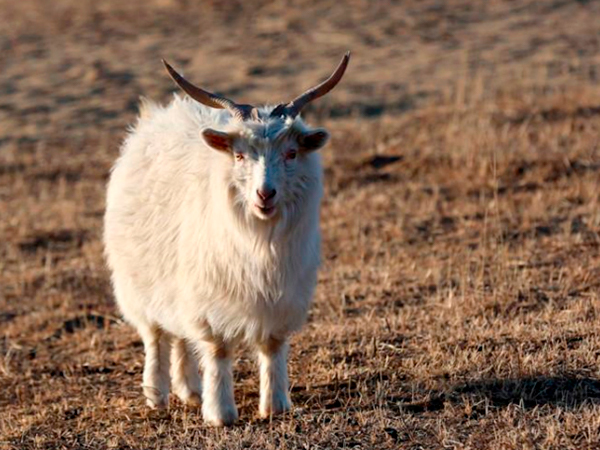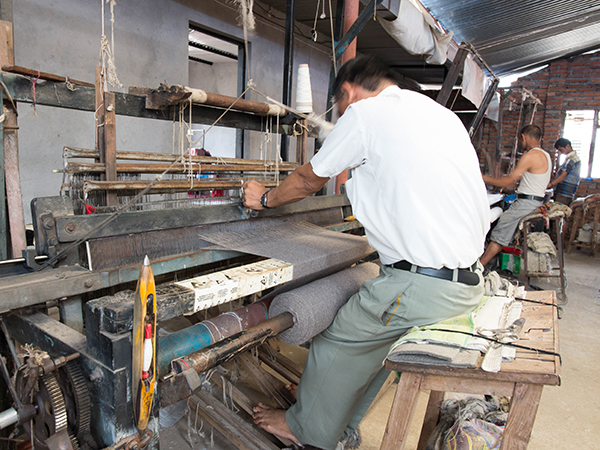 There are a lot of myths about pashmina floating around out there. The biggest misconception of them all seems to be what the difference between cashmere and pashmina is. To make the story short, there is absolutely no difference! Both pashmina and cashmere are fabrics made from the undercoat of domesticated goats living on high elevations primarily in Himalaya. During the cold winters the goats develop a very fine undercoat that works as insulation. The goat is often referred to as Capra hircus laniger, but there is not exactly a special bred called the cashmere goat. Any goat that can produce fibres in the required thickness and length can produce the precious wool.
There are a lot of myths about pashmina floating around out there. The biggest misconception of them all seems to be what the difference between cashmere and pashmina is. To make the story short, there is absolutely no difference! Both pashmina and cashmere are fabrics made from the undercoat of domesticated goats living on high elevations primarily in Himalaya. During the cold winters the goats develop a very fine undercoat that works as insulation. The goat is often referred to as Capra hircus laniger, but there is not exactly a special bred called the cashmere goat. Any goat that can produce fibres in the required thickness and length can produce the precious wool.
However, the longer story is not so simple. Today the term pashmina is labelled on all sorts of fabric. It seems like the term pashmina by now has lost its meaning completely.
In the recent years the term pashmina has been used to describe a wide variety of products. All from 100% cashmere to blends of cashmere and silk. Even the famous water pashmina you find on markets in Kathmandu, which usually is a mix of sheep wool and polyamide, is labelled as pashmina.
The word pashmina itself is not a legally recognizable term for describing fibres content by European or American law. If a textile product contains cashmere, the fibre content must be declared as cashmere on required labelling. Pashmina is prohibited to be used on textile product labelling in the absence of the legally required terminology. Textile products composed of blends of cashmere and silk fibres must be labelled with the appropriate percentages of the composites and designated as such according to textile and Customs labelling regulations.
A few myths about pashmina
Beside the composition and labelling issues, there are numerous myths and urban legends that surrounds this coveted textile. We have collected a list of the ones we encounter most often.
Grade A is the best pashmina quality
There are no official classifications of pashmina wool. In general quality terms like Grade A and superior cashmere should be considered as a marketing trick to convince the buyer that the product is superior to other products. However, the raw wool is classified and after the pashmina wool is collected, the raw wool is sorted in colour and and fibre thickness. The colour is white or different shades of grey or brown. The white wool is most expensive since it can be dyed any colour. Also, the delicate pastel colours. The thinner and longer the fibres is the more expensive.
Pashmina should be soft and fluffy
This is not necessarily true. In fact, some pashmina shawls can seem to be a little stiff depending on the weaving pattern and how tight it is woven. But don't worry, it will get softer with use. Unfortunately, because of this misunderstanding some manufacturers are artificially softening the fabric using chemicals or by brushing it. None of these techniques are recommended since the trade-off is a weaker fabric.
You get the most value for money buying your pashmina shawls in Kathmandu
 You can definitely be lucky to find a bargain in Kathmandu. However, there are literally thousands of pashmina stores competing for the tourists' attention and money. Sadly, it is a race to the bottom where price and quality have been plummeting during the last decades. Most of the shawls you find are what we call "tourist quality" which is fabric made from sheep wool and polyamide. To make a sound investment for your wardrobe you really have to know the product you are going to buy. Can you tell the difference between real and fake pashmina? If not, you are an easy target for the slick sellers.
You can definitely be lucky to find a bargain in Kathmandu. However, there are literally thousands of pashmina stores competing for the tourists' attention and money. Sadly, it is a race to the bottom where price and quality have been plummeting during the last decades. Most of the shawls you find are what we call "tourist quality" which is fabric made from sheep wool and polyamide. To make a sound investment for your wardrobe you really have to know the product you are going to buy. Can you tell the difference between real and fake pashmina? If not, you are an easy target for the slick sellers.
First class pashmina doesn't pill
Not entirely true. The very cheap cashmere made from leftovers from the primary production tend to pill very easily. However even high-quality products will spawn these fuzzy balls when rubbed against other fabric. If you are wearing your pashmina shawl under a jacket or coat you will risk experiencing issues with pilling.
Pashmina and cashmere is too warm to wear in the summer
Pashmina wool is hygroscopic. This means it is naturally breathable. It can keep you cool when it’s hot and warm when it’s not. Pashmina is capable at leading moisture away from your body, making it a great shroud when the sun is out.
Real pashmina is produced only in the Kashmir region in India
The Kashmir region in India won a trade dispute giving them the exclusive right to use the term pashmina. In Nepal where we a producing our pashminas we have to settle for the tern chyangra pashmina. Our products are just as good. It is analogue to the Champagne region in France. It is the only place where you can produce champagne. It does not mean that you cannot produce excellent sparkling wine elsewhere.
The more plies, the better fabric
The yarn ply refers to how many threads that are twisted together to one yarn. Threads can be twisted together to make thicker threads. In general yarns of multiple plies of threads are smother and stronger than single ply yarn, which tends to be fluffier but also a bit weaker. For woven fabrics multiple plies tends to give a stronger and smoother fabric. On the other hand, single ply yarn tends to be more bushy and fluffy which can be desirable for certain purposes. So which is better depends on which features you will add to the product.
Hand looms are superior to machine looms
 This is not always the case, and it basically depends weather the weaver can master the loom or not. This is not an easy job and it requires many years of training to obtain the adequate skills. The advantage of the machine loom is that quality is consistent and there will be less flaws in the textile. However, in order to weave the ultra-thin yarns, the treads cannot be under as high tension as on its hand-controlled counterpart. The higher the tension, the higher the risk of breaking the yarn.
This is not always the case, and it basically depends weather the weaver can master the loom or not. This is not an easy job and it requires many years of training to obtain the adequate skills. The advantage of the machine loom is that quality is consistent and there will be less flaws in the textile. However, in order to weave the ultra-thin yarns, the treads cannot be under as high tension as on its hand-controlled counterpart. The higher the tension, the higher the risk of breaking the yarn.
All our pashmina shawls and cashmere scarves are manufactured by artisan weavers on authentic hand looms. There will inevitably be small flaws here and there, but we have a strict quality control and all our products have a very high standard.
Pashmina is high maintenance and should be dry cleaned only
This is not true. You can easily wash your pashmina gently by hand or in a machine on a special wool program. In fact we recommend the machine wash since it will rinse out the soap better than hand washing it. Furthermore, the machine will squeeze more water out of the fabric reducing the time it takes to dry it. Never tumble dry pashmina or cashmere, and always use a special wool soap.
Pashmina wool is only gathered from chest and belly of the goat
This is not true at all. The pashmina fibres come from the undercoat of the animal which extends all around it. Remember it is the ultra-fine undercoat that keeps the goats warm in the extreme temperatures. The animals would simply not survive the harsh winters if only certain parts of their bodies were covered with the fine wool.
Shatoosh is superior to pashmina
Due to the fact that pashmina fibres are removed from live goats, the animals are not harmed during the process of collecting the wool. The herders live in communion with their domesticated goats; although it is a difficult life for the herders and goats living in the frigid Mongolian winter months, the lives of the herders and animals are respected. "Shatoosh" is not cashmere or pashmina.
The term shatoosh describes the fine hair from the Tibetan antelope, which is being killed for this hair and is traded illegally under Chinese and international law.









